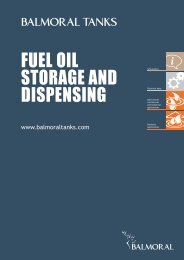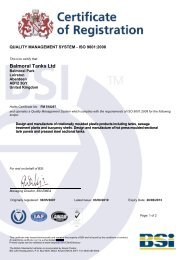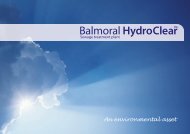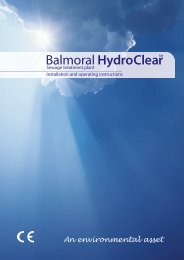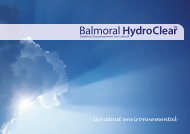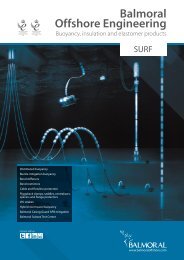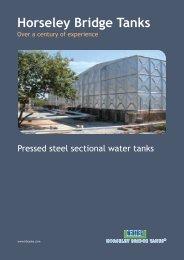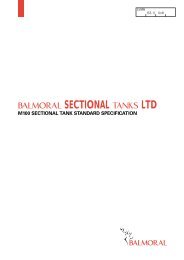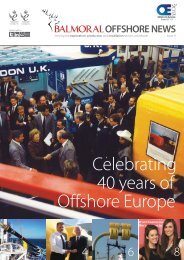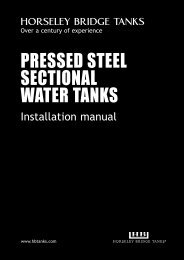BOE News issue 7 (PDF 1mb) - Balmoral Group
BOE News issue 7 (PDF 1mb) - Balmoral Group
BOE News issue 7 (PDF 1mb) - Balmoral Group
Create successful ePaper yourself
Turn your PDF publications into a flip-book with our unique Google optimized e-Paper software.
Issue 7 | <strong>Balmoral</strong> Offshore <strong>News</strong><br />
7<br />
Pure foam systems<br />
In parallel to the development of composite, ie, macrosphere-containing<br />
syntactic foams, <strong>Balmoral</strong> has developed a family of pure syntactic<br />
materials to cover all requirements from the ‘commodity’ end of the<br />
market through to the highest performance, deepest depth rating,<br />
lowest density systems. Please refer to Table 2.<br />
Pure foam systems offer many advantages over macrosphere composite<br />
foams including very low water ingress characteristics, robustness, ease<br />
of repair and modification in the event of damage or design alterations.<br />
Pure foam systems represent the high performance end of the market<br />
and are therefore typically used in more demanding service conditions<br />
such as extreme depths and/or service criticality.<br />
The performance of this particular ultra-low density material is<br />
understood to be unique in that the buoyancy does not progressively<br />
reduce due to hydrostatic compression as the ROV flies into deeper<br />
waters. This is because the bulk modulus - compressibility under<br />
hydrostatic pressure - of the foams is marginally less than sea water.<br />
<strong>Balmoral</strong>’s portfolio includes the flagship low density foam (LDF) range<br />
with depth ratings to 7000msw with a 10000msw foam in development.<br />
The performance of the LDF range is unique as the buoyancy<br />
performance is practically unaffected by hydrostatic pressure and<br />
derives from the use of a completely different thermoset resin system to<br />
all other syntactic foams on the market. Please refer to Table 3.<br />
ROV/AUV external finishing<br />
The selection of a barrier coating on buoyancy modules of any type is a<br />
critical <strong>issue</strong>. These coatings provide impact and abrasion resistance<br />
while offering high visibility smooth gloss finishes.<br />
The most common finish is a 3-5mm sprayed elastomer applied to all<br />
external surfaces to give a highly effective coating for work class ROVs.<br />
Standard pigmentation is yellow, orange, red or white although other<br />
colours can be provided to match project parameters.<br />
Global deployment<br />
David Clayton, sales director at <strong>Balmoral</strong> said: “The development of our<br />
ROV LDF systems has moved <strong>Balmoral</strong> to the forefront of ROV buoyancy<br />
module supply.<br />
Table 1: Composite foam material values<br />
Typical<br />
operating<br />
Typical core density kg/m 3<br />
depth<br />
ft/msw<br />
GRE<br />
Carbon<br />
1500/457 346 -<br />
2000/610 358 -<br />
3000/915 385 -<br />
4000/1220 417 403<br />
5000/1524 455 432<br />
6000/1829 479 450<br />
7000/2134 514 476<br />
8000/2439 535 491<br />
9000/2744 565 515<br />
10000/3049 586 530<br />
Table 2: Pure foam standard range (PFS)<br />
Typical operating<br />
depth ft/msw<br />
Typical core density kg/m 3<br />
5750/1750 560<br />
8200/2500 585<br />
10000/3000 610<br />
15000/4500 635<br />
20000/6000 660<br />
23000/7000 710<br />
Table 3: Pure foam ultra-low density range (LDF)<br />
Typical operating<br />
depth ft/msw<br />
Typical core density kg/m 3<br />
5000/1500 400<br />
6500/2000 430<br />
10000/3000 450<br />
16500/5000 510<br />
23000/7000 550<br />
“Relationships with a number of leading manufacturers have seen<br />
'preferred supplier' status being gained for 3000msw and deeper rated<br />
flotation. In the last 12 months we have supplied dozens of work class<br />
ROV buoyancy sets as well as intervention tooling packs destined for the<br />
deeper waters of Brazil, Gulf of Mexico and West Africa.<br />
Photo courtesy of Fugro<br />
“Ultra deep dive research applications for 5000msw+ have seen<br />
buoyancy packs shipped to France, Italy, the USA and Japan.”



